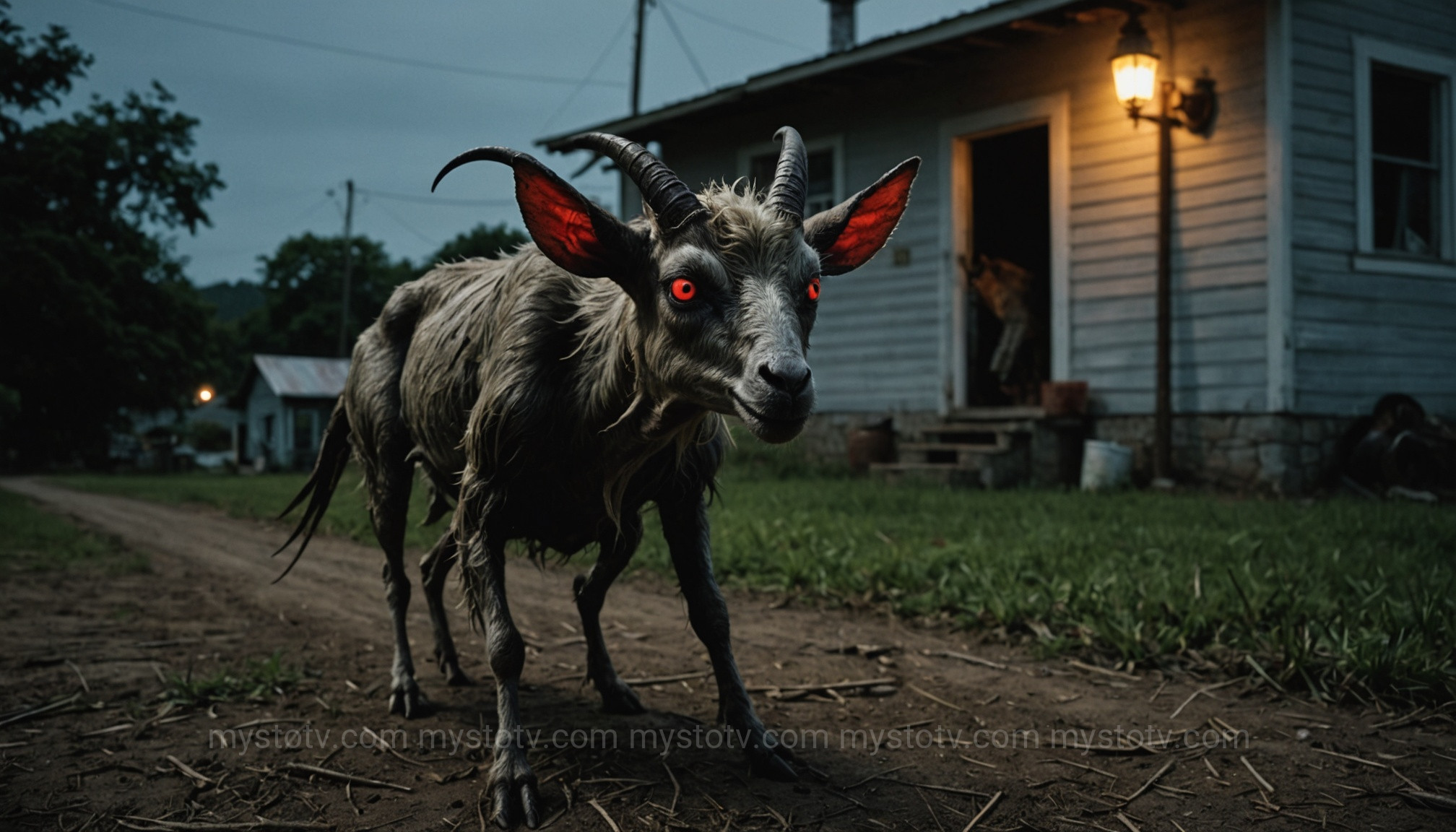I still remember the feeling—sitting cross-legged on the floor of my local library, a heavy, oversized book open on my lap. The pages were filled with grainy photos and eerie illustrations of creatures that supposedly lurked just beyond the edge of our understanding. For me, it wasn't about whether they were real; it was the thrilling possibility that our world still held such profound mysteries. That childhood fascination with the unknown is the very heart of cryptozoology, the study of hidden animals. This exploration isn't just a monster hunt; it's a journey into folklore, human psychology, and the enduring power of a good story. This comprehensive cryptid creatures list is a tribute to that sense of wonder, exploring the most famous, fearsome, and fascinating beings that haunt our collective imagination.
Contents
- 1 Understanding Cryptozoology and the Cryptid Creatures List
- 2 The Giants of the Land: A Cryptid Creatures List of Hominids and Terrestrial Beasts
- 3 Monsters of the Deep: A Cryptid Creatures List of Aquatic Mysteries
- 4 Terrors from the Sky: A Cryptid Creatures List of Winged Enigmas
- 5 Modern Myths and Strange Hybrids: An Evolving Cryptid Creatures List
- 6 The Cultural Footprint: Why We're Fascinated by the Cryptid Creatures List
- 7 Frequently Asked Questions (FAQ)
- 8 Conclusion
- 9 References
Understanding Cryptozoology and the Cryptid Creatures List

Before diving into the creatures themselves, it's crucial to understand the field they belong to. Cryptozoology, a term coined by zoologist Bernard Heuvelmans in the 1950s, is the study of and search for animals whose existence is unproven. These animals, known as cryptids, occupy a liminal space between science and folklore. They are not mythical creatures like unicorns or dragons, which are generally accepted as purely symbolic. Instead, cryptids are beings that, according to eyewitness accounts and anecdotal evidence, could potentially be real, undiscovered species, survivors of supposed extinction, or misidentified known animals.
A cryptid creatures list is more than a catalog of monsters; it's a record of humanity's relationship with the natural world. It reflects our anxieties about the dark woods, the deep oceans, and the shadows in our own backyards. The analysis of this list reveals patterns: many cryptids are reported in areas of vast, unexplored wilderness, while others emerge from specific cultural anxieties or historical events. The evidence for their existence ranges from compelling footprints and blurry photographs to firsthand testimonies that are as sincere as they are difficult to verify. In essence, cryptozoology is a quest to find the "why" behind the sightings as much as the "what."
The Giants of the Land: A Cryptid Creatures List of Hominids and Terrestrial Beasts
Perhaps the most iconic figures in cryptozoology are the bipedal, ape-like humanoids and massive land animals said to roam the world's most remote forests and mountains. These creatures tap into a primal fear of the "wild man" and the humbling idea that we may not be the only intelligent primates to walk the Earth. This section of our cryptid creatures list explores these terrestrial titans.
Bigfoot (Sasquatch)

Bigfoot, also known by the Salish name Sasquatch, is the undisputed king of North American cryptids. Described as a large, hairy, ape-like hominid standing between 7 and 10 feet tall, it is said to inhabit the vast wilderness of the Pacific Northwest. Sightings are part of a long tradition of "wild man" stories in Indigenous cultures. Modern interest exploded in the 1950s, but the most famous piece of evidence remains the 1967 Patterson-Gimlin film, which purports to show a female Sasquatch walking across a creek bed in Northern California. Despite decades of debate and scientific scrutiny, the film has never been definitively debunked or proven authentic.
Analysis: The endurance of the Bigfoot legend speaks to a deep-seated desire in the American psyche for untamed wilderness and a connection to a more primitive world. The creature represents a frontier that can never be fully conquered, a living embodiment of nature's power to hold secrets from a world that is increasingly mapped and cataloged.
The Yeti
The Yeti, or "Abominable Snowman," is Bigfoot's Himalayan cousin. Woven into the folklore of the Sherpa people, the Yeti is typically described as a large, shaggy primate that dwells in the snow-capped peaks of the Himalayas. Western fascination with the creature grew in the early 20th century as mountaineers began exploring the region and reporting large, unidentifiable tracks in the snow. Most famously, explorer Eric Shipton photographed a clear, large footprint in 1951 near Mount Everest, sparking a global sensation. Scientific analysis of alleged Yeti samples (hair, bone) has often pointed to known animals like the Himalayan brown bear or Tibetan blue bear, suggesting misidentification is a key factor.
Analysis: Unlike Bigfoot, the Yeti is deeply embedded in the spiritual landscape of its region. It is not just an animal but a figure of reverence and fear, a guardian of the sacred mountains. The debate around the Yeti highlights the tension between local, traditional knowledge and Western scientific inquiry, making it a fascinating entry on any cryptid creatures list.
Monsters of the Deep: A Cryptid Creatures List of Aquatic Mysteries
The world's oceans, lakes, and rivers remain one of our planet's last true frontiers. With over 80% of the ocean unexplored, it's easy to imagine that large, unknown animals could thrive in the crushing depths. This section of the cryptid creatures list dives into the waters to find the serpents and leviathans of lore.
The Loch Ness Monster (Nessie)

No list of cryptids is complete without the Loch Ness Monster. "Nessie," as she's affectionately known, is said to be a large marine animal inhabiting Loch Ness in the Scottish Highlands. The legend is ancient, with a 6th-century text mentioning a "water beast," but the modern phenomenon began in 1933. The most iconic image, the 1934 "Surgeon's Photograph," was later revealed to be a hoax. However, this did little to quell public fascination. Decades of sonar scans, expeditions (like Operation Deepscan in 1987), and eyewitness reports have kept the mystery alive. The most popular theory is that Nessie is a surviving plesiosaur, a long-necked marine reptile from the age of dinosaurs.
Analysis: Nessie's story is a masterclass in modern myth-making, tourism, and hope. The creature transformed a remote Scottish loch into a world-famous destination. The belief in Nessie represents a romantic wish for a "living fossil," a direct link to a prehistoric past that science tells us is long gone. It is a testament to how a single story can shape the identity and economy of a place.
Mokele-mbembe
Deep within the Congo River Basin, tales are told of a creature known as Mokele-mbembe, meaning "one who stops the flow of rivers." Eyewitnesses, including local villagers and Western explorers, describe it as a large, semi-aquatic animal, roughly the size of an elephant, with a long neck and tail, resembling a sauropod dinosaur. Accounts claim it is a herbivore that lives in the region's vast, swampy interiors. Expeditions have been launched to find the creature since the early 20th century, but the impenetrable terrain has made definitive proof elusive.
Analysis: Mokele-mbembe is a compelling entry on the cryptid creatures list because it exists at the intersection of post-colonial adventure narrative and legitimate zoological possibility. The Congo Basin is one of the least-explored regions on Earth, making the idea of an undiscovered large animal plausible. However, the creature's description so closely matches a popular conception of a dinosaur that it raises questions about cultural feedback loops and the influence of paleontological discoveries on modern folklore.
Terrors from the Sky: A Cryptid Creatures List of Winged Enigmas
From strange omens to terrifying predators, the sky has always been a source of mystery. The cryptids that are said to soar through our airspace are often the most bizarre and terrifying, blending animalistic features with humanoid or demonic characteristics. This part of our cryptid creatures list looks upward to the beings that haunt the night sky.
The Mothman
Between 1966 and 1967, the town of Point Pleasant, West Virginia, was plagued by sightings of a bizarre entity known as the Mothman. It was described as a large, winged humanoid figure with glowing red eyes. Over a hundred people reported encounters with the creature. The sightings culminated in a tragic event: the collapse of the Silver Bridge on December 15, 1967, which killed 46 people. Author John Keel, in his book The Mothman Prophecies, linked the creature to the disaster, cementing its status as a harbinger of doom.
Analysis: The Mothman is more than just an animal; it's a modern paranormal phenomenon. Its story weaves together elements of cryptozoology, ufology (witnesses often reported strange lights and "men in black"), and precognition. Mothman reflects a specific kind of modern anxiety—not of the untamed wild, but of inexplicable disaster and the feeling of being watched by forces beyond our control. It’s a powerful example of how a community can process trauma through folklore.
The Jersey Devil
The official state demon of New Jersey, the Jersey Devil, has haunted the Pine Barrens for over 250 years. According to the most popular legend, it was the 13th child of a woman known as Mother Leeds, who cursed the child upon its birth in 1735. It was said to have transformed into a grotesque creature with a horse-like head, large bat-like wings, horns, and a forked tail. The most intense period of sightings occurred in one week in 1909, when over 1,000 people across the state claimed to have seen the creature, causing widespread panic.
Analysis: The Jersey Devil is a prime example of how a cryptid creatures list entry can originate from and be sustained by regional folklore. Its story is rooted in colonial-era anxieties about religion, witchcraft, and the "uncivilized" wilderness of the Pine Barrens. The tale has been passed down for generations, becoming an inseparable part of New Jersey's cultural identity.
Modern Myths and Strange Hybrids: An Evolving Cryptid Creatures List
A cryptid creatures list is not a static document. New creatures emerge over time, often reflecting contemporary fears or spreading rapidly through modern media. These recent additions are often strange hybrids, blending the features of known animals in unsettling ways.
The Chupacabra

The Chupacabra (Spanish for "goat-sucker") is one of the newest and most famous cryptids. It first appeared in Puerto Rico in 1995, with reports of a strange, bipedal creature with grayish skin, large alien-like eyes, and sharp spines running down its back. It was blamed for a series of livestock killings where the animals were found drained of blood. The phenomenon then spread to Mexico and the Southwestern United States. Interestingly, the American version of the Chupacabra evolved into a completely different-looking animal: a strange, hairless, four-legged canid.
Analysis: The Chupacabra is a fascinating case study in viral folklore. The original Puerto Rican description bears a striking resemblance to the alien "Sil" from the 1995 film Species, which the first witness admitted to having seen. The later "mangy canid" sightings in Texas and elsewhere have almost all been identified as coyotes or raccoons suffering from severe sarcoptic mange. The Chupacabra's evolution shows how a legend can adapt and change as it crosses cultural and geographical borders, influenced by media and local fauna.
The Dogman
The Michigan Dogman is a cryptid reported from the state of Michigan, described as a seven-foot-tall, bipedal wolf-like creature with a canine head and a humanoid body. While sightings have been reported for years, the legend was largely popularized by a 1987 song by radio DJ Steve Cook. The song, created as an April Fool's prank, detailed historical encounters with the creature and led to an influx of listeners calling in with their own alleged sightings. The Dogman is often associated with a ten-year cycle of appearances.
Analysis: The Dogman phenomenon illustrates the power of media in creating and consolidating a cryptid legend. Cook's song provided a name and a narrative framework for disparate, localized sightings of strange canids. It gave people a specific monster to attribute their experiences to, transforming a collection of anecdotes into a cohesive and enduring piece of regional folklore.
The Cultural Footprint: Why We're Fascinated by the Cryptid Creatures List
Why does the cryptid creatures list continue to captivate us in an age of science and technology? The answer lies not in the woods or the water, but within ourselves. These creatures fulfill a deep human need for mystery. In a world that feels increasingly known and predictable, cryptids represent the possibility that there are still great discoveries to be made, that the map is not yet complete.
They are also powerful cultural metaphors. Bigfoot and the Yeti embody the wildness we have lost. The Loch Ness Monster represents a tangible link to a romanticized, ancient past. Mothman and the Chupacabra are personifications of modern anxieties, from technological failure to fears of the "other." They are canvases onto which we project our hopes, our fears, and our desire to believe in something just beyond the reach of our everyday lives. As long as there are shadows on the edge of the woods and unexplained ripples in the water, our list of cryptids will continue to grow. This enduring fascination is perhaps the most interesting aspect of the modern cryptid phenomena.
Frequently Asked Questions (FAQ)
What is the difference between a cryptid and a mythical creature?
The key difference lies in the framework of belief. A mythical creature, like a griffin or a phoenix, is generally understood to be symbolic and part of a mythological or allegorical system. There is no expectation of finding a living specimen. A cryptid, on the other hand, is considered a "hidden animal" that is treated as potentially real within the field of cryptozoology. Believers and researchers seek evidence for cryptids with the hope of one day classifying them as actual biological species.
Has any animal from a cryptid creatures list ever been proven to exist?
Yes, in a way. Many animals that are now known to science were once effectively cryptids to the cultures that discovered them. The gorilla was considered a myth by Westerners until confirmed in the 19th century. The okapi, a "forest giraffe" from Central Africa, was known only through local stories until it was scientifically described in 1901. The coelacanth, a fish thought to be extinct for 66 million years, was rediscovered in 1938. These discoveries fuel the hope that other cryptids may one day be found.
What is the most plausible cryptid?
Plausibility is subjective, but many researchers would point to creatures that could be surviving populations of known-but-rare species or that inhabit vast, underexplored territories. Large, unknown marine invertebrates like the giant squid (once a cryptid itself) or terrestrial apes in remote jungles are often considered more plausible than creatures with supernatural traits or those said to live in heavily populated areas. Mokele-mbembe in the Congo Basin is often cited as a plausible candidate due to the sheer size and inaccessibility of its alleged habitat.
Conclusion
From the towering Sasquatch of the Pacific Northwest to the blood-chilling Chupacabra of Latin America, the global cryptid creatures list is a rich tapestry of folklore, fear, and enduring fascination. These beings are more than just campfire stories; they are a reflection of our relationship with the natural world and the unknown. They challenge our perceptions of reality, forcing us to question what might be lurking just beyond the light of scientific certainty. Whether they are undiscovered species, misidentified animals, or powerful archetypes born from the human psyche, these creatures prove one thing: our world is far more mysterious and wonderful than we often give it credit for. The search for them is, in the end, a search for the last great wildernesses—both on our planet and within our own minds.
References
- Coleman, Loren, and Jerome Clark. Cryptozoology A-Z: The Encyclopedia of Loch Monsters, Sasquatch, Chupacabras, and Other Authentic Mysteries of Nature. Fireside, 1999.
- Heuvelmans, Bernard. On the Track of Unknown Animals. Kegan Paul, 1995 (reissue).
- Keel, John A. The Mothman Prophecies: A True Story. Tor Books, 2002 (reissue).
- Radford, Ben. "The Chupacabra Mystery." Live Science, 28 October 2010.
- Regal, Brian. Searching for Sasquatch: Crackpots, Eggheads, and Cryptozoology. Palgrave Macmillan, 2011.